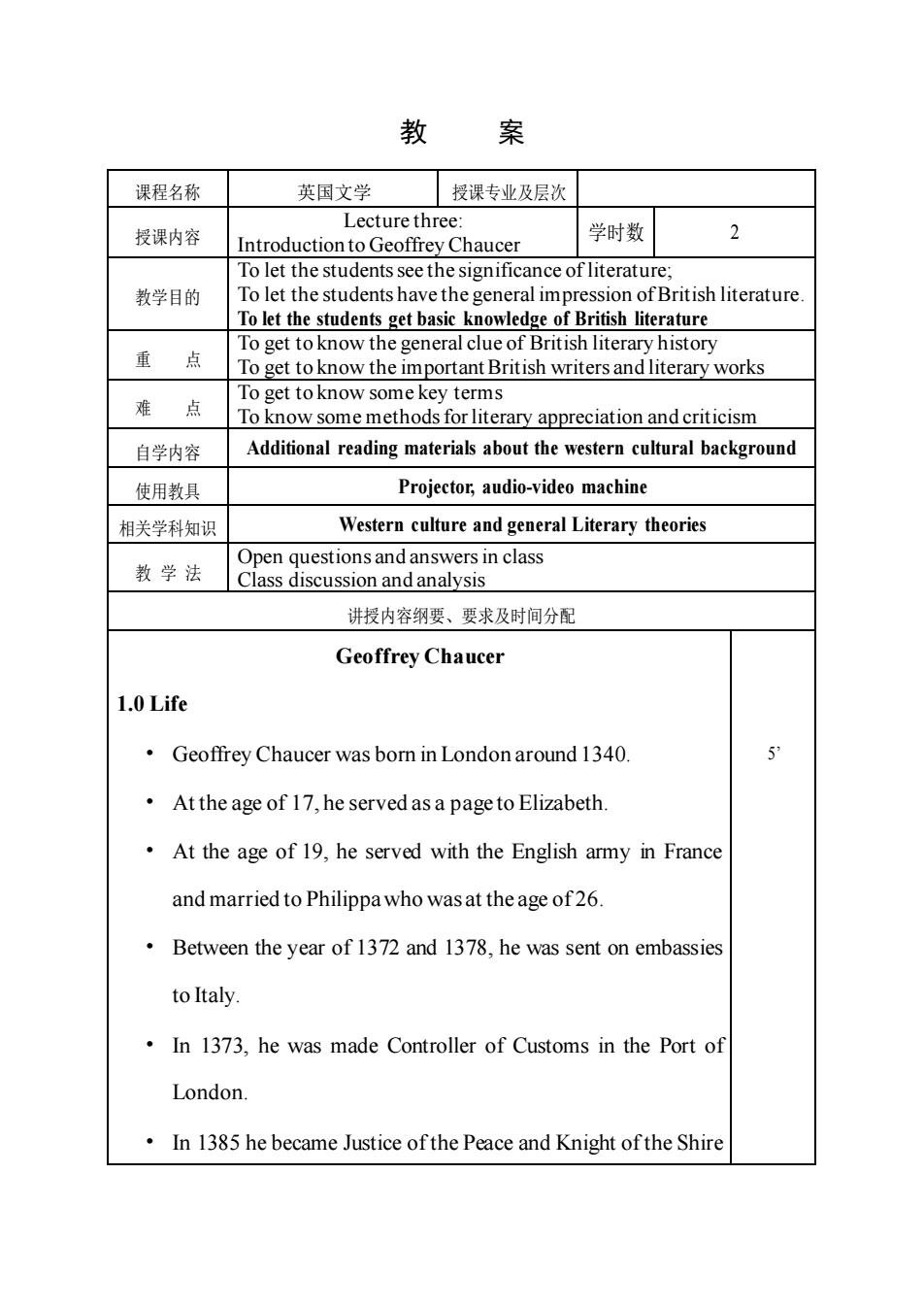
教 案 课程名称 英国文学 授课专业及层次 授课内容 Lecture three: 学时数 Introduction to geoffrey Chaucer 2 To let the students see the significance ofliterature 教学目的 Tolet the studentshavethe general im ssion of British literature Toet the studentsget basic knowledge of British iterature 重点 To get to know the general clue of British literary history To get to know the important British writers and literary works To get toknow some key terms 难点 自学内容 Additional reading materials about the western cultural background 使用教具 Projector,audio-video machine 相关学科知识 Western culture and general Literary theories Open questions and answers in class 教学法Class discussion and analysis 讲授内容纲要、要求及时间分配 Geoffrey Chaucer 1.0Life Geoffrey Chaucer was bomn in London around 1340. 5 Atthe age of 17,he served as a pageto Elizabeth At the age of 19,he served with the English army in France and married to Philippa who was at the age of 26. Between the year of 1372 and 1378,he was sent on embassies to Italy. In 1373,he was made Controller of Customs in the Port of London. In 1385 he became Justice of the Peace and Knight of the Shire
教 案 课程名称 英国文学 授课专业及层次 授课内容 Lecture three: Introduction to Geoffrey Chaucer 学时数 2 教学目的 To let the students see the significance of literature; To let the students have the general impression of British literature. To let the students get basic knowledge of British literature 重 点 To get to know the general clue of British literary history To get to know the important British writers and literary works 难 点 To get to know some key terms To know some methods for literary appreciation and criticism 自学内容 Additional reading materials about the western cultural background 使用教具 Projector, audio-video machine 相关学科知识 Western culture and general Literary theories 教 学 法 Open questions and answers in class Class discussion and analysis 讲授内容纲要、要求及时间分配 Geoffrey Chaucer 1.0 Life • Geoffrey Chaucer was born in London around 1340. • At the age of 17, he served as a page to Elizabeth. • At the age of 19, he served with the English army in France and married to Philippa who was at the age of 26. • Between the year of 1372 and 1378, he was sent on embassies to Italy. • In 1373, he was made Controller of Customs in the Port of London. • In 1385 he became Justice of the Peace and Knight of the Shire 5’
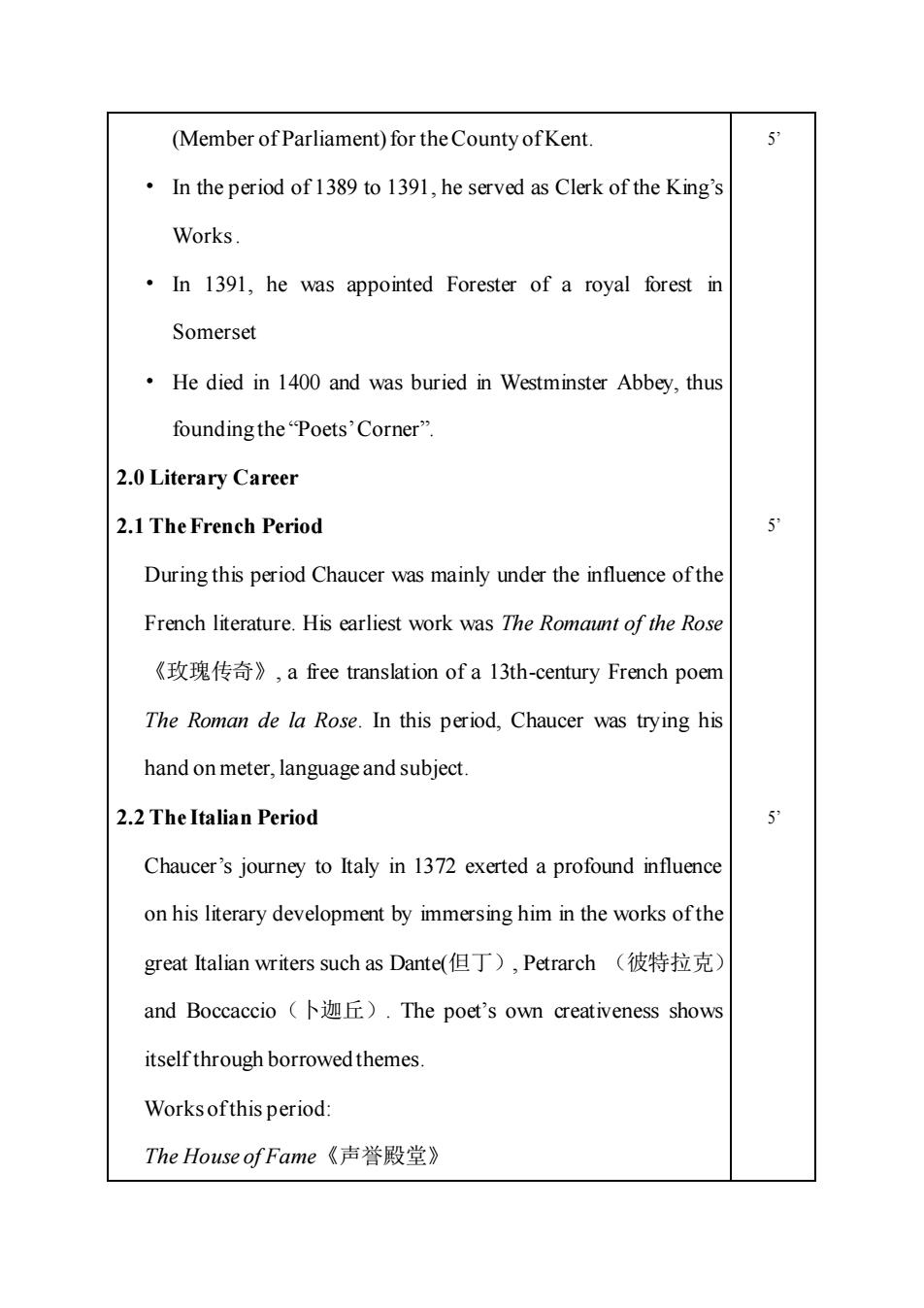
(Member of Parliament)for the County ofKent. In the period of 1389 to 1391,he served as Clerk of the King's Works. In 1391,he was appointed Forester of a royal forest in Somerset He died in 1400 and was buried in Westminster Abbey,thus foundingthe"Poets'Corner". 2.0 Literary Career 2.1 The French Period During this period Chaucer was mainly under the influence ofthe French literature.His earliest work was The Romaunt of the Rose 《玫瑰传奇》,a free translation of a 13th-century French poem The Roman de la Rose.In this period,Chaucer was trying his hand on meter,language and subject. 2.2 The Italian Period 5 Chaucer's journey to Italy in 1372 exerted a profound influence on his literary development by immersing him in the works ofthe great Italian writers such as Dante(但丁),Petrarch(彼特拉克 and Boccaccio(卜迦丘).The poet's own creativeness shows itself through borrowed themes Works ofthis period: The House of Fame《声誉殿堂》
(Member of Parliament) for the County of Kent. • In the period of 1389 to 1391, he served as Clerk of the King’s Works . • In 1391, he was appointed Forester of a royal forest in Somerset • He died in 1400 and was buried in Westminster Abbey, thus founding the “Poets’ Corner”. 2.0 Literary Career 2.1 The French Period During this period Chaucer was mainly under the influence of the French literature. His earliest work was The Romaunt of the Rose 《玫瑰传奇》, a free translation of a 13th-century French poem The Roman de la Rose. In this period, Chaucer was trying his hand on meter, language and subject. 2.2 The Italian Period Chaucer’s journey to Italy in 1372 exerted a profound influence on his literary development by immersing him in the works of the great Italian writers such as Dante(但丁), Petrarch (彼特拉克) and Boccaccio(卜迦丘). The poet’s own creativeness shows itself through borrowed themes. Works of this period: The House of Fame《声誉殿堂》 5’ 5’ 5’
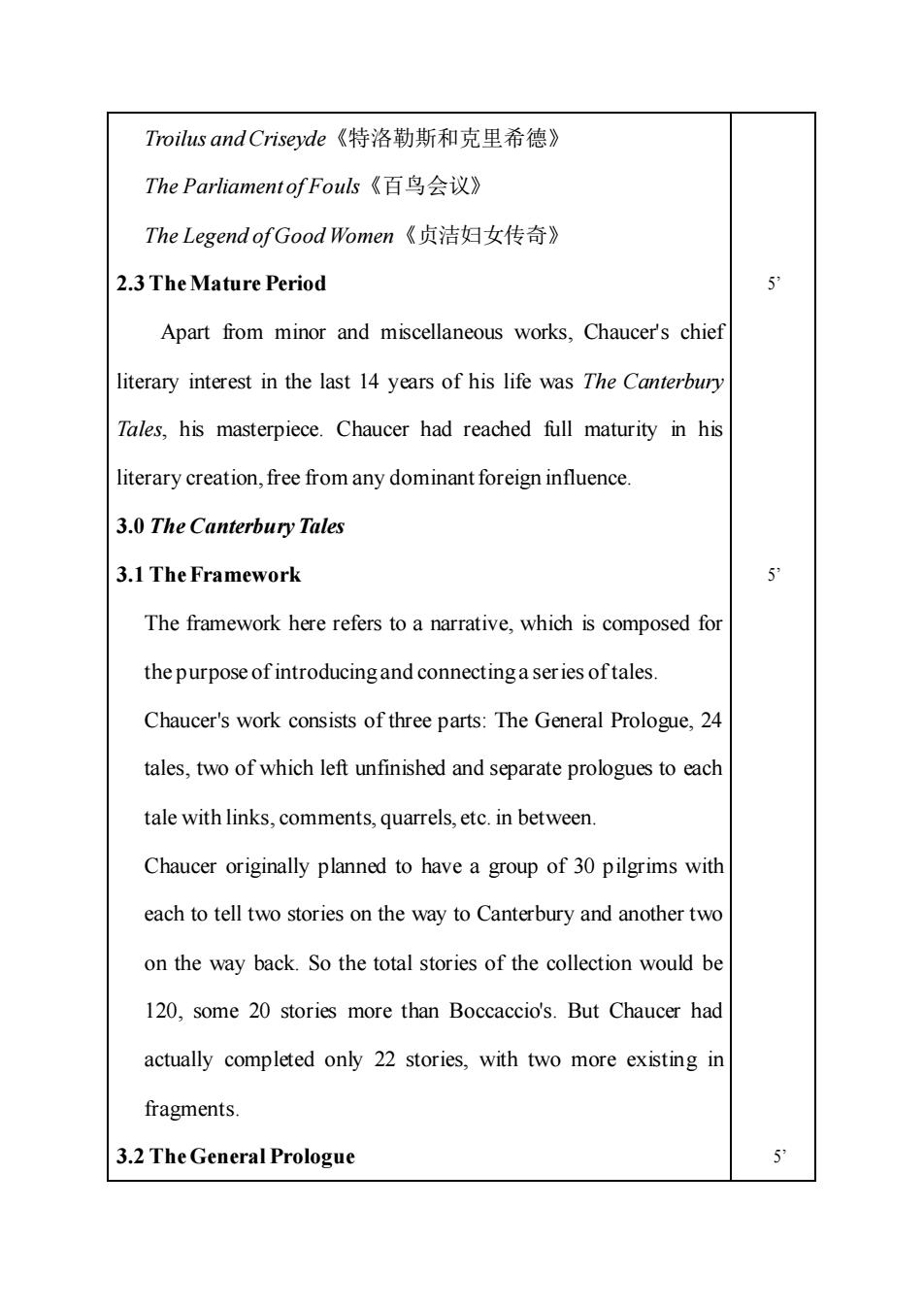
Troilus and Criseyde《特洛勒斯和克里希德》 The Parliamentof Fouls《百鸟会议》 The Legend of Good Women《贞洁妇女传奇》 2.3 The Mature Period 5 Apart from minor and miscellaneous works,Chaucer's chief literary interest in the last 14 years of his life was The Canterbury Tales,his masterpiece.Chaucer had reached full maturity in his literary creation,free from any dominant foreign influence. 3.0 The Canterbury Tales 3.1 The Framework 5 The framework here refers to a narrative.which is composed for the purpose of introducingand connectinga series oftales Chaucer's work consists of three parts:The General Prologue,24 tales,two of which left unfinished and separate prologues to each tale with links,comments,quarrels,etc.in between. Chaucer originally planned to have a group of 30 pilgrims with each to tell two stories on the way to Canterbury and another two on the way back.So the total stories of the collection would be 120,some 20 stories more than Boccaccio's.But Chaucer had actually completed only 22 stories,with two more existing in fragments. 3.2 The General Prologue
Troilus and Criseyde《特洛勒斯和克里希德》 The Parliament of Fouls《百鸟会议》 The Legend of Good Women《贞洁妇女传奇》 2.3 The Mature Period Apart from minor and miscellaneous works, Chaucer's chief literary interest in the last 14 years of his life was The Canterbury Tales, his masterpiece. Chaucer had reached full maturity in his literary creation, free from any dominant foreign influence. 3.0 The Canterbury Tales 3.1 The Framework The framework here refers to a narrative, which is composed for the purpose of introducing and connecting a series of tales. Chaucer's work consists of three parts: The General Prologue, 24 tales, two of which left unfinished and separate prologues to each tale with links, comments, quarrels, etc. in between. Chaucer originally planned to have a group of 30 pilgrims with each to tell two stories on the way to Canterbury and another two on the way back. So the total stories of the collection would be 120, some 20 stories more than Boccaccio's. But Chaucer had actually completed only 22 stories, with two more existing in fragments. 3.2 The General Prologue 5’ 5’ 5’
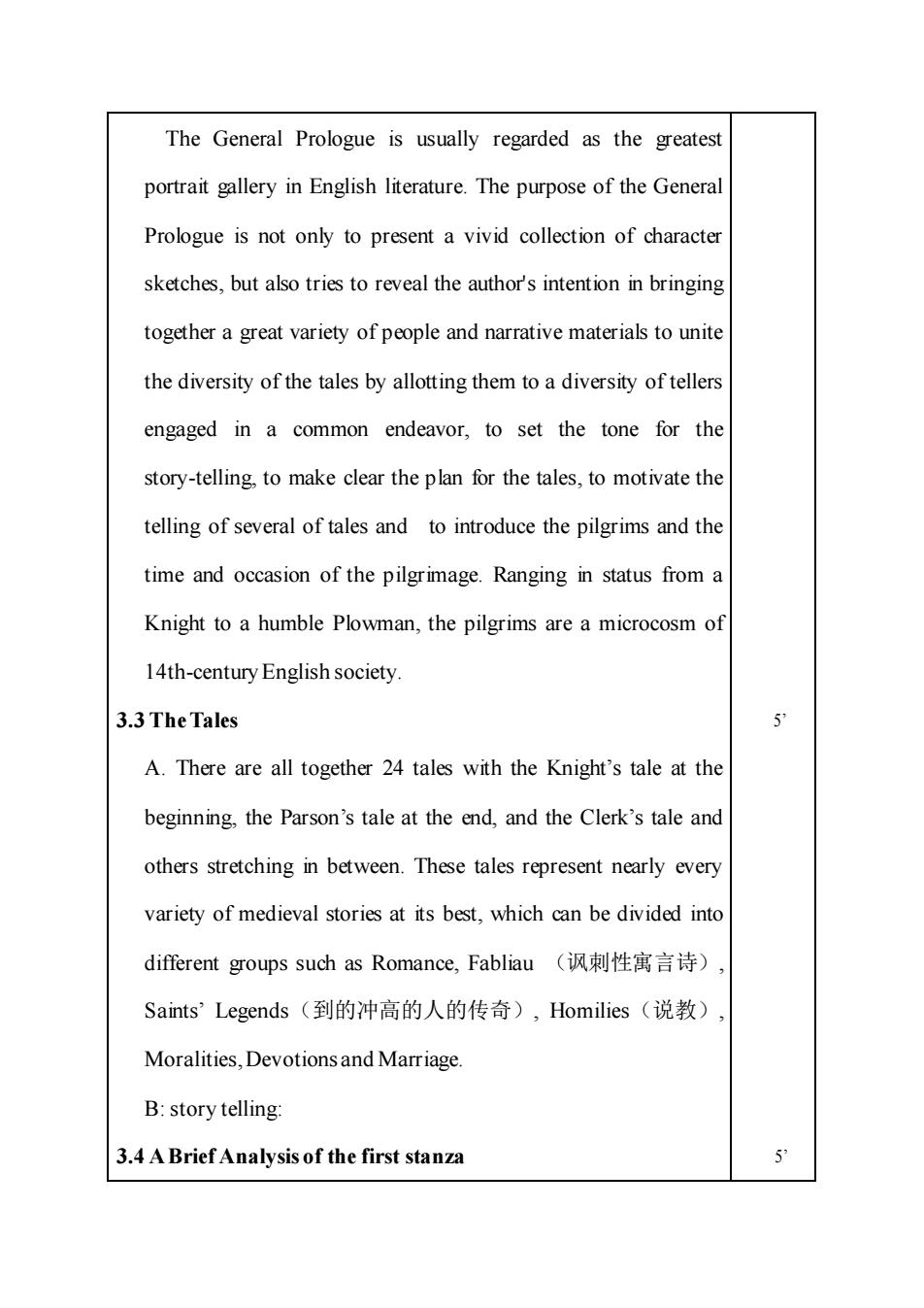
The General Prologue is usually regarded as the greatest portrait gallery in English literature.The purpose of the General Prologue is not only to present a vivid collection of character sketches,but also tries to reveal the author's intention in bringing together a great variety of people and narrative materials to unite the diversity of the tales by allotting them to a diversity of tellers engaged in a common endeavor,to set the tone for the story-telling,to make clear the plan for the tales,to motivate the telling of several of tales and to introduce the pilgrims and the time and occasion of the pilgrimage.Ranging in status from a Knight to a humble Plowman,the pilgrims are a microcosm of 14th-century English society. 3.3TheTales A.There are all together 24 tales with the Knight's tale at the beginning.the Parson's tale at the end,and the Clerk's tale and others stretching in between.These tales represent nearly every variety of medieval stories at its best,which can be divided into different groups such as Romance,.Fabliau(讽刺性寓言诗) Saints'Legends(到的冲高的人的传奇),Homilies(说教) Moralities,Devotions and Marriage B:story telling: 3.4 A Brief Analysis of the first stanza
The General Prologue is usually regarded as the greatest portrait gallery in English literature. The purpose of the General Prologue is not only to present a vivid collection of character sketches, but also tries to reveal the author's intention in bringing together a great variety of people and narrative materials to unite the diversity of the tales by allotting them to a diversity of tellers engaged in a common endeavor, to set the tone for the story-telling, to make clear the plan for the tales, to motivate the telling of several of tales and to introduce the pilgrims and the time and occasion of the pilgrimage. Ranging in status from a Knight to a humble Plowman, the pilgrims are a microcosm of 14th-century English society. 3.3 The Tales A. There are all together 24 tales with the Knight’s tale at the beginning, the Parson’s tale at the end, and the Clerk’s tale and others stretching in between. These tales represent nearly every variety of medieval stories at its best, which can be divided into different groups such as Romance, Fabliau (讽刺性寓言诗), Saints’ Legends(到的冲高的人的传奇), Homilies(说教), Moralities, Devotions and Marriage. B: story telling: 3.4 A Brief Analysis of the first stanza 5’ 5’
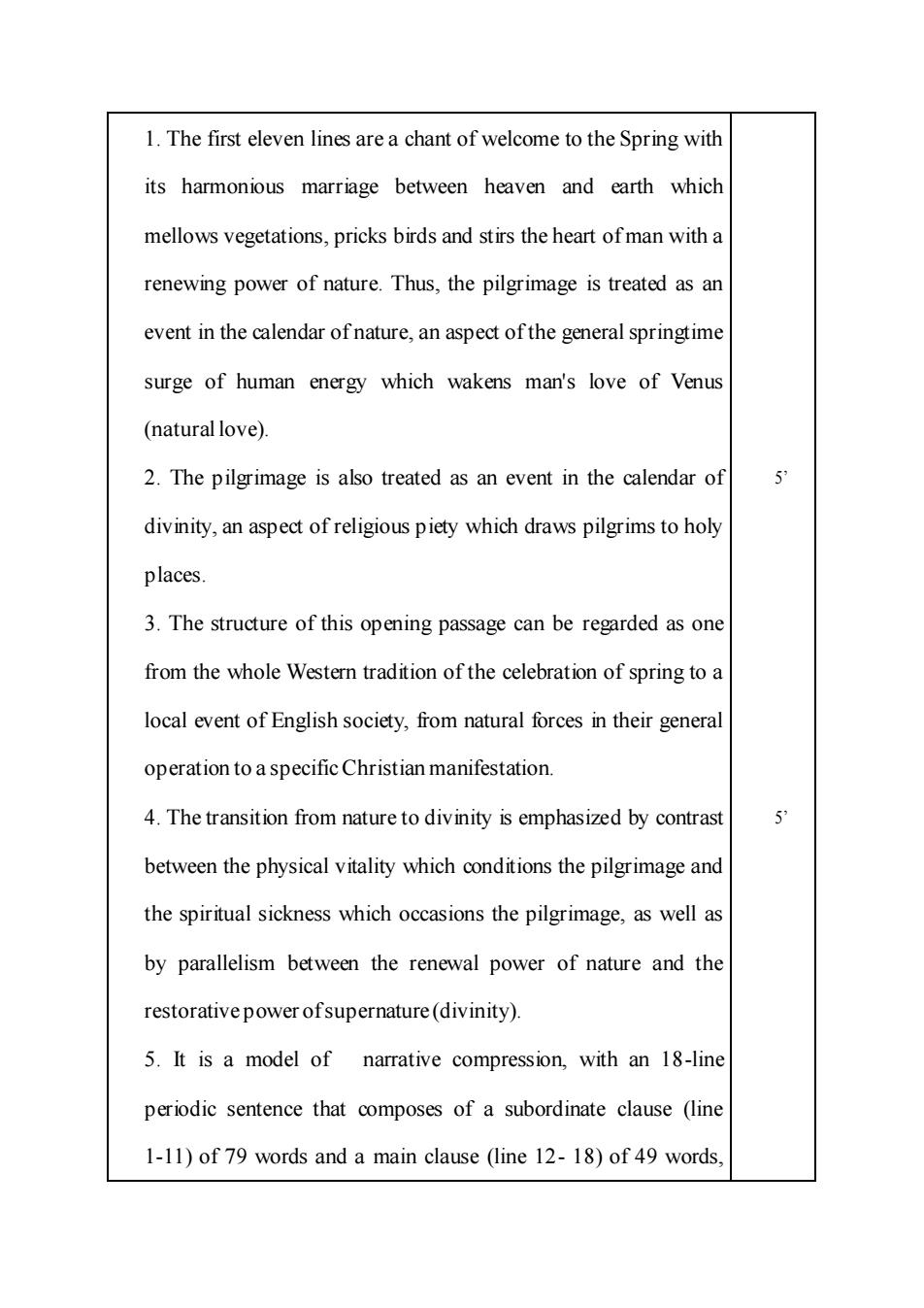
1.The first eleven lines are a chant of welcome to the Spring with its harmonious marriage between heaven and earth which mellows vegetations,pricks birds and stirs the heart ofman with a renewing power of nature.Thus,the pilgrimage is treated as ar event in the calendar of nature,an aspect ofthe general springtime surge of human energy which wakens man's love of Venus (natural love). 2.The pilgrimage is also treated as an event in the calendar of 5 divinity,an aspect of religious piety which draws pilgrims to holy places. 3.The structure of this opening passage can be regarded as one from the whole Western tradition of the celebration of spring to a local event of English society,from natural forces in their general operation to a specific Christian manifestation. 4.The transition from nature to divinity is emphasized by contrast 5 between the physical vitality which conditions the pilgrimage and the spiritual sickness which occasions the pilgrimage,as well as by parallelism between the renewal power of nature and the restorative power ofsupernature(divinity). 5.It is a model of narrative compression,with an 18-line periodic sentence that composes of a subordinate clause (line 1-11)of 79 words and a main clause (line 12-18)of 49 words
1. The first eleven lines are a chant of welcome to the Spring with its harmonious marriage between heaven and earth which mellows vegetations, pricks birds and stirs the heart of man with a renewing power of nature. Thus, the pilgrimage is treated as an event in the calendar of nature, an aspect of the general springtime surge of human energy which wakens man's love of Venus (natural love). 2. The pilgrimage is also treated as an event in the calendar of divinity, an aspect of religious piety which draws pilgrims to holy places. 3. The structure of this opening passage can be regarded as one from the whole Western tradition of the celebration of spring to a local event of English society, from natural forces in their general operation to a specific Christian manifestation. 4. The transition from nature to divinity is emphasized by contrast between the physical vitality which conditions the pilgrimage and the spiritual sickness which occasions the pilgrimage, as well as by parallelism between the renewal power of nature and the restorative power of supernature (divinity). 5. It is a model of narrative compression, with an 18-line periodic sentence that composes of a subordinate clause (line 1-11) of 79 words and a main clause (line 12- 18) of 49 words, 5’ 5’
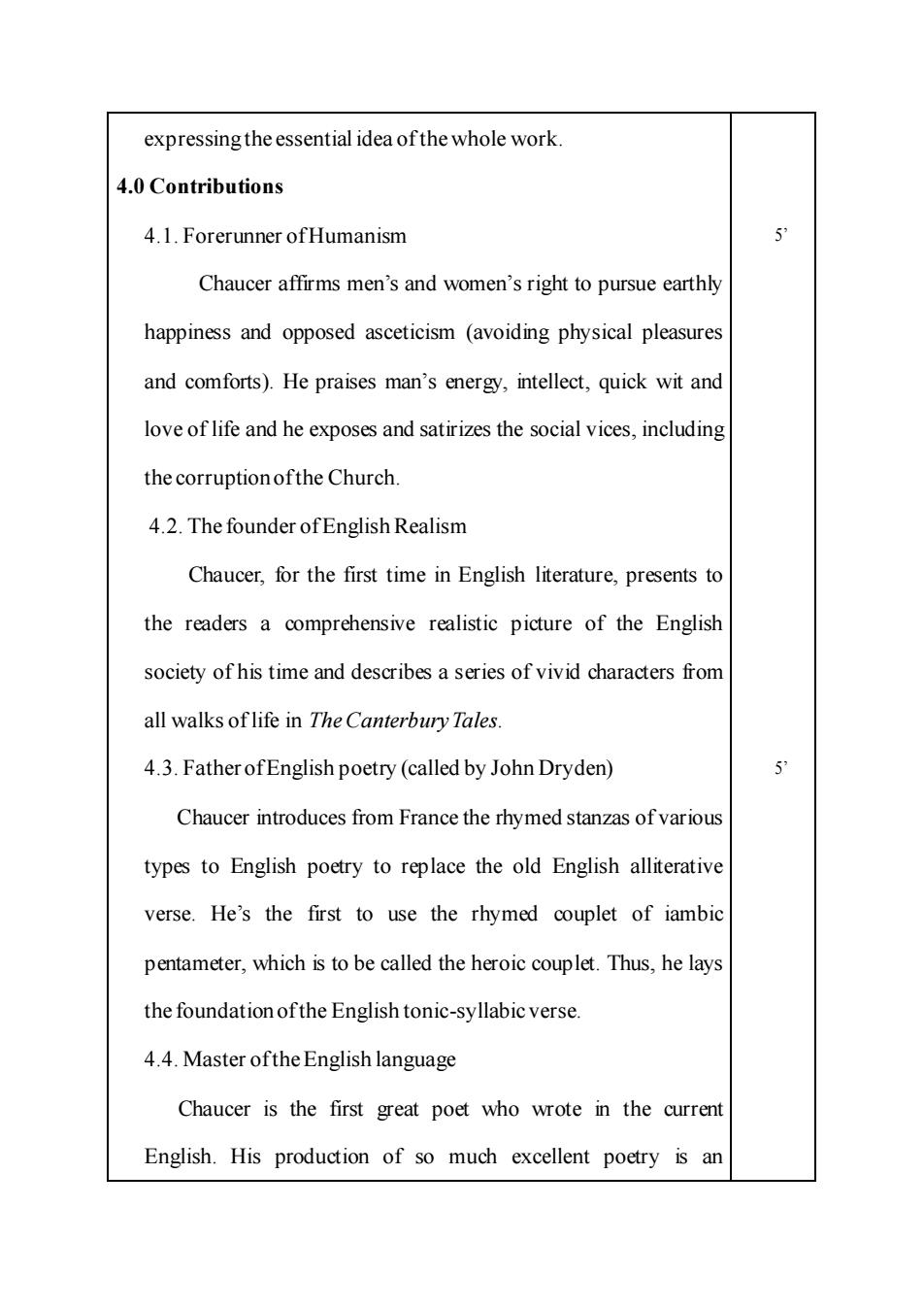
expressingthe essential idea ofthe whole work 4.0 Contributions 4.1.Forerunner ofHumanism Chaucer affirms men's and women's right to pursue earthly happiness and opposed asceticism (avoiding physical pleasures and comforts).He praises man's energy,intellect,quick wit and love of life and he exposes and satirizes the social vices,including the corruption ofthe Church. 4.2.The founder ofEnglish Realism Chaucer,for the first time in English literature,presents to the readers a comprehensive realistic picture of the English society of his time and describes a series of vivid characters from all walks of life in The Canterbury Tales. 4.3.Father ofEnglish poetry(called by John Dryden) 5 Chaucer introduces from France the rhymed stanzas of various types to English poetry to replace the old English alliterative verse.He's the first to use the rhymed couplet of iambic pentameter,which is to be called the heroic couplet.Thus,he lays the foundation ofthe English tonic-syllabic verse. 4.4.Master ofthe English language Chaucer is the first great poet who wrote in the current English.His production of so much excellent poetry is an
expressing the essential idea of the whole work. 4.0 Contributions 4.1. Forerunner of Humanism Chaucer affirms men’s and women’s right to pursue earthly happiness and opposed asceticism (avoiding physical pleasures and comforts). He praises man’s energy, intellect, quick wit and love of life and he exposes and satirizes the social vices, including the corruption of the Church. 4.2. The founder of English Realism Chaucer, for the first time in English literature, presents to the readers a comprehensive realistic picture of the English society of his time and describes a series of vivid characters from all walks of life in The Canterbury Tales. 4.3. Father of English poetry (called by John Dryden) Chaucer introduces from France the rhymed stanzas of various types to English poetry to replace the old English alliterative verse. He’s the first to use the rhymed couplet of iambic pentameter, which is to be called the heroic couplet. Thus, he lays the foundation of the English tonic-syllabic verse. 4.4. Master of the English language Chaucer is the first great poet who wrote in the current English. His production of so much excellent poetry is an 5’ 5’
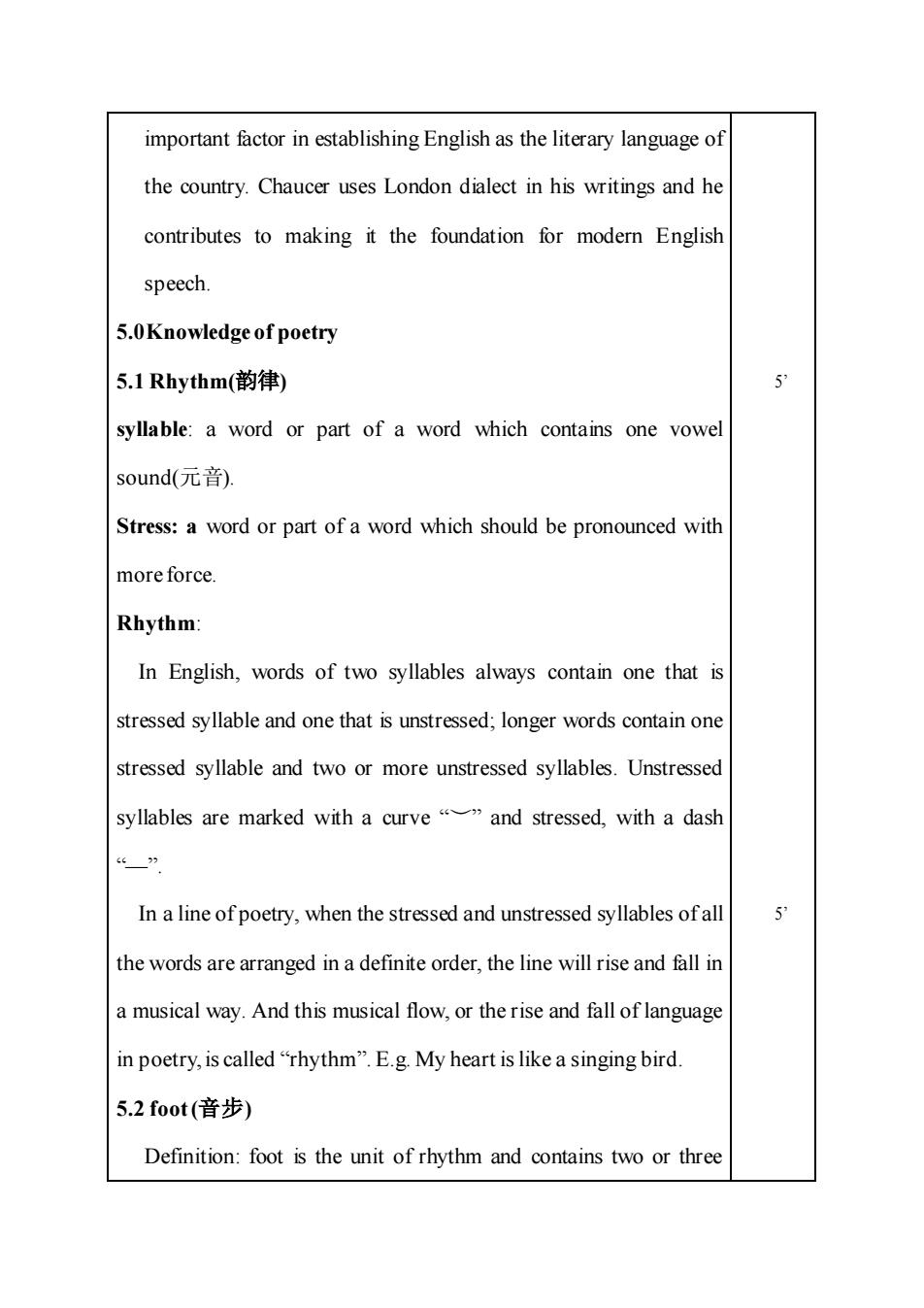
important factor in establishing English as the literary language of the country.Chaucer uses London dialect in his writings and he contributes to making it the foundation for modern English speech. 5.0Knowledge of poetry 5.1 Rhythm(韵律) syllable:a word or part of a word which contains one vowel sound(元音). Stress:a word or part of a word which should be pronounced with more force. Rhythm: In English,words of two syllables always contain one that is stressed syllable and one that is unstressed;longer words contain one stressed syllable and two or more unstressed syllables.Unstressed syllables are marked with a curve""and stressed,with a dash ” In a line of poetry,when the stressed and unstressed syllables ofall 5 the words are arranged in a definite order,the line will rise and fall in a musical way.And this musical flow,or the rise and fall of language in poetry,is called"Thythm".E.g My heart is like a singing bird. 5.2f0ot(音步) Definition:foot is the unit of rhythm and contains two or three
important factor in establishing English as the literary language of the country. Chaucer uses London dialect in his writings and he contributes to making it the foundation for modern English speech. 5.0Knowledge of poetry 5.1 Rhythm(韵律) syllable: a word or part of a word which contains one vowel sound(元音). Stress: a word or part of a word which should be pronounced with more force. Rhythm: In English, words of two syllables always contain one that is stressed syllable and one that is unstressed; longer words contain one stressed syllable and two or more unstressed syllables. Unstressed syllables are marked with a curve “︶” and stressed, with a dash “—”. In a line of poetry, when the stressed and unstressed syllables of all the words are arranged in a definite order, the line will rise and fall in a musical way. And this musical flow, or the rise and fall of language in poetry, is called “rhythm”. E.g. My heart is like a singing bird. 5.2 foot (音步) Definition: foot is the unit of rhythm and contains two or three 5’ 5’
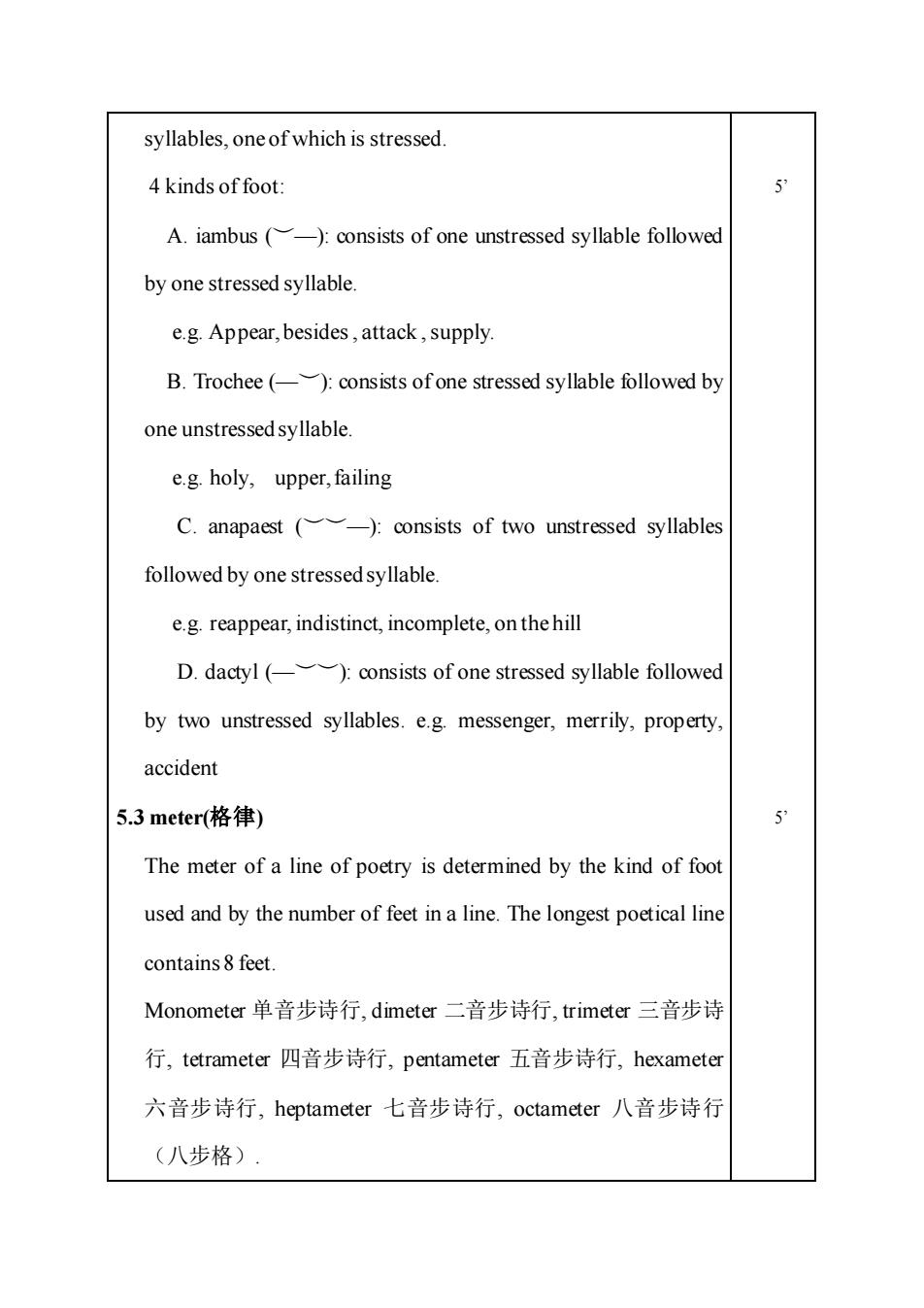
syllables,one of which is stressed. 4 kinds of foot: 5 A.iambus ()consists of one unstressed syllable followed by one stressed syllable e.g.Appear,besides,attack,supply. B.Trochee(-):consists of one stressed syllable followed by one unstressedsyllable. e.g.holy,upper,failing C.anapaest ()consists of two unstressed syllables followed by one stressed syllable. e.g.reappear,indistinct,incomplete,on the hill D.dactyl ()consists of one stressed syllable followed by two unstressed syllables.e.g.messenger,merrily,property. accident 5.3 meter(格律) 5 The meter of a line of poetry is determined by the kind of foot used and by the number of feet in a line.The longest poetical line contains8 feet. Monometer单音步诗行,dimeter二音步诗行,trimeter三音步诗 行,tetrameter四音步诗行,pentameter五音步诗行,hexameter 六音步诗行,heptameter七音步诗行,octameter八音步诗行 (八步格)
syllables, one of which is stressed. 4 kinds of foot: A. iambus (︶—): consists of one unstressed syllable followed by one stressed syllable. e.g. Appear, besides , attack , supply. B. Trochee (—︶): consists of one stressed syllable followed by one unstressed syllable. e.g. holy, upper, failing C. anapaest (︶︶—): consists of two unstressed syllables followed by one stressed syllable. e.g. reappear, indistinct, incomplete, on the hill D. dactyl (—︶︶): consists of one stressed syllable followed by two unstressed syllables. e.g. messenger, merrily, property, accident 5.3 meter(格律) The meter of a line of poetry is determined by the kind of foot used and by the number of feet in a line. The longest poetical line contains 8 feet. Monometer 单音步诗行, dimeter 二音步诗行, trimeter 三音步诗 行, tetrameter 四音步诗行, pentameter 五音步诗行, hexameter 六音步诗行, heptameter 七音步诗行, octameter 八音步诗行 (八步格). 5’ 5’

A line of five iambic feet is an iambic pentameter line A line of six dactylic feet is a dactylic hexameter line. e.g.but every eye was fixed on her alone. On her white breast a sparklingcrossshe wore 5.4Rime 5 Rime is a repetition of the same sound at the end of two or more lines. E.g.day,may;wore,adore. 5.5 stanza A stanza is a group of two or more consecutive lines bound together by end rime. UsualIy,we use letters to represent the rime scheme(押韵方式) A.couplet:aa bb cc. B.terza rima(三行换韵):aba bcb cdc ded. C.Quatrain(四行诗体):thereare.4 rimeschemes 1)abed Then come home,my children,the sun in gone down And the dews of night arise. Come,come,leave offplay,and let us away Till the morningappear in the skies 2)aaba 5 A book of Verses underneath the Bough
A line of five iambic feet is an iambic pentameter line. A line of six dactylic feet is a dactylic hexameter line. e.g. but every eye was fixed on her alone. On her white breast a sparkling cross she wore 5.4 Rime Rime is a repetition of the same sound at the end of two or more lines. E.g. day, may; wore, adore. 5.5 stanza A stanza is a group of two or more consecutive lines bound together by end rime. Usually, we use letters to represent the rime scheme(押韵方式). A. couplet: aa bb cc. B. terza rima(三行换韵):aba bcb cdc ded. C. Quatrain(四行诗体): there are 4 rime schemes 1) abcd Then come home, my children, the sun in gone down And the dews of night arise. Come, come, leave off play, and let us away Till the morning appear in the skies. 2) aaba A book of Verses underneath the Bough 5’ 5’

A Jug of Wine,a Loaf of Bread-and Thou Beside me singing in the wilderness- Oh,Wilderness were Paradise enow! 3)abab 4)abba D.quintette:ababb E.sextette:ababcc F.septette:ababbcc G.octave:abababcc H.nonette:ababbcbcc 5.6 Heroic Couplet(英雄双韵体) They are poetry composed in iambic pentameter.In this form of poetry,lines consisting offive iambic feet rime together in pairs. The rime scheme:aa bb cc. poem→stanza→line→foot-→syllable
A Jug of Wine, a Loaf of Bread- and Thou Beside me singing in the wilderness- Oh, Wilderness were Paradise enow! 3) abab 4) abba D. quintette: ababb E. sextette: ababcc F. septette: ababbcc G. octave: abababcc H. nonette: ababbcbcc 5.6 Heroic Couplet(英雄双韵体) They are poetry composed in iambic pentameter. In this form of poetry, lines consisting of five iambic feet rime together in pairs. The rime scheme :aa bb cc . poem→stanza→line→foot→syllable 5’